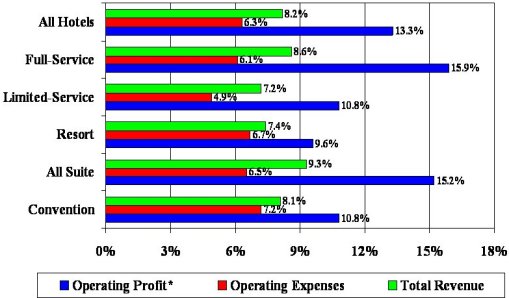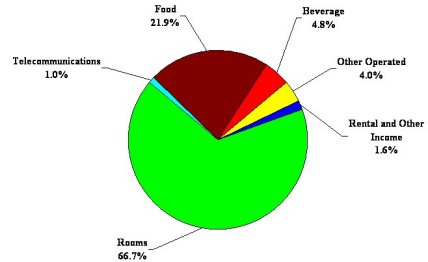 |
|
News for the Hospitality Executive |
 |
Strong Gains in Hotel Revenues
Overcome Expense Growth
.
| By: Robert Mandelbaum, August 2007
A familiar pattern repeated itself in 2006 � strong gains in hotel revenues surpassed significant expense growth, which resulted in double-digit increases in unit level hotel profits. In 2006, the average hotel manager in our Trends in the Hotel Industry survey achieved a 13.3 percent gain in operating profits , the third consecutive year of bottom-line increases in excess of ten percent. Favorable supply / demand conditions allowed these operators to enjoy an 8.2 percent jump in revenues for the year. However, management continued to struggle with burgeoning costs. Hotel operating expenses grew 6.3 percent in 2006, the third consecutive year of expense growth nearly twice the pace of inflation. These finding are based on the 2007 edition of Trends in the Hotel Industry. To monitor lodging industry revenues, expense, and profits, PKF Consulting has collected and analyzed the operating statements of thousands of hotels in the U.S. since 1936. ADR Drives Revenue With most markets achieving occupancy levels at or above their long term average, it was expected that ADR growth would begin to dominate revenue growth. Such was the case in 2006. An 8.3 percent gain in average room rates (ADR) was the main driver of the 8.2 percent increase in total revenue for the properties in the Trends survey. The 8.3 percent growth rate was the strongest annual increase in ADR observed since 1996. Concurrently, occupancy rose just 0.4 percent. The net result was an 8.8 percent gain in rooms revenue, or RevPAR. In 2006, hotels also enjoyed the benefit of increased revenue from sources
other than the rental of guest rooms. Food and beverage revenues
grew 7.1 percent, while sales in other operated departments (gift shop,
golf, spa, movies, parking etc...) increased 5.9 percent. On the
negative side, telecommunications revenue declined (-5.5 percent) for the
sixth consecutive year.
Change In Unit Level Revenues, Expenses, and Profits* 2005 to 2006 
Note: * Before deductions for capital reserve, rent, interest, income taxes, depreciation, and amortization. Source: PKF Hospitality Research . Mix Of Revenues 2006 
Source: PKF Hospitality Research Out of Control Costs In total, all operating costs at U.S. hotels increased 6.3 percent from 2005 to 2006. When looking beneath these data, we generally find that the costs that management has least control over exhibited the greatest year over year growth. Measured on a percentage basis, the two expense items that increased the most from 2005 to 2006 were management fees (10.0 percent) and franchise fees (9.5 percent). Since these fees are typically charged as a percentage of revenue, the sharp increases were attributable to the strong revenue gains generated by the management company and franchise affiliation. Utility (7.3 percent) and insurance costs (9.5 percent) are two other expense items over which management has limited control that grew significantly in 2006. While lodging properties can enact energy conservation policies, the cost of utilities is heavily influenced by the prices that are approved by the local service provider. After moderating in 2004 and 2005, insurance costs climbed back upwards in 2006 (9.5 percent) and grew more than three times the pace of inflation. With effective training and the ability to adjust staffing schedules to meet fluctuating volumes of business, hotel managers do have some degree of control over labor costs. This is extremely important since salaries, wages, and benefits constituted 44.5 cents of every dollar spent to operate a hotel in 2006. For the year, U.S. hotel labor costs increased a relatively modest 4.8 percent. However, what continues to concern management is the fact that the growth in labor costs was driven primarily by the increase in employee benefits. A large component of employee benefits consists of government mandated employee related taxes and insurance that is out of the control of management. Profit Growth For All With revenue expanding at a greater pace than expenses, hotel operating profits increased 13.3 percent in 2006. Fortunately for hotel owners and operators, all property types enjoyed healthy gains on the bottom-line. Full-service and all-suite hotels achieved the greatest gains in profits among the five property categories covered in our Trends survey. These property types enjoyed profit gains of 15.9 percent and 15.2 percent respectively. Limited-service and convention hotels saw their bottom-lines� surge by 10.8 percent, while resorts achieved a profit increase of 9.6 percent. Unfortunately, the exuberance of long-term participants in the industry
is somewhat muted because of the staggering declines in profitability absorbed
during the 2001 to 2003 industry recession. In real terms, 2006 unit
level hotel profits were 20.9 percent behind those achieved in 2000.
Change In Select Unit Level Revenues And Expenses 2005 - 2006 
Note: * Before deductions for capital reserve, rent, interest, income taxes, depreciation, and amortization. Source: PKF Hospitality Research Moderation In The Future The near-term outlook for the U.S. lodging industry remains favorable. However, it is unrealistic to expect profit growth to continue on a double-digit pace. More hotel projects are starting to move through the development pipeline and into the construction phase. In addition, we are starting to observe some degree of rate resistance among corporate travel executives, meeting planners, and gas-gouged leisure travelers. We do not foresee an industry recession anytime soon, but revenue and profits increases more in line with long-term averages is most likely. In the July 2006 issue of Lodging magazine, PKF Hospitality Research
forecast revenue growth of 7.6 percent for 2006, along with a 14.9 percent
gain in profitability - pretty close to the results that were actually
achieved. Looking towards the end of 2007, our forecast calls for
a 4.7 percent increase in revenues and a 6.5 percent boost in profits.
For reference purposes, the long-term (1960 to 2006) average annual change
in revenue is 4.5 percent and 4.7 percent for profits. As history
has proven, the lodging industry is cyclical and performance will eventually
revert to the mean.
Robert Mandelbaum is Director of Research Information Services for PKF Hospitality Research. He is located in the firm�s Atlanta office. To purchase a copy of the 2007 Trends in the Hotel Industry report, visit www.pkfc.com. This article was published in the July 2007 edition of Lodging Magazine. |
| Contact:
Robert Mandelbaum
|
| Also See: | U.S. Hotels: Revenues and Profits Rise, But So Do Expenses / 2006 Trends in the Hotel Industry / May 2006 |
|
|